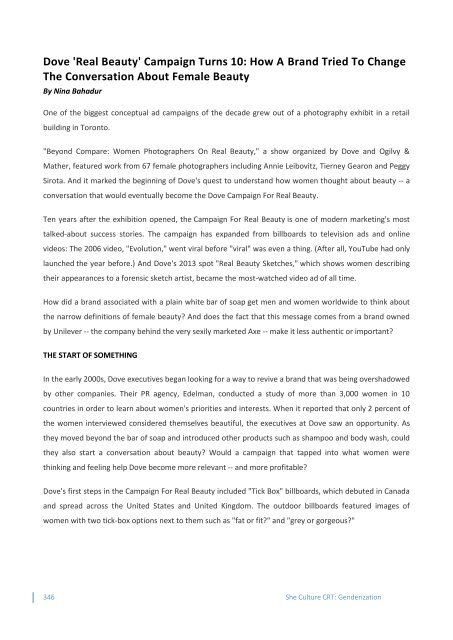7.Genderization
7.Genderization
7.Genderization
Create successful ePaper yourself
Turn your PDF publications into a flip-book with our unique Google optimized e-Paper software.
Dove 'Real Beauty' Campaign Turns 10: How A Brand Tried To ChangeThe Conversation About Female BeautyBy Nina BahadurOne of the biggest conceptual ad campaigns of the decade grew out of a photography exhibit in a retailbuilding in Toronto."Beyond Compare: Women Photographers On Real Beauty," a show organized by Dove and Ogilvy &Mather, featured work from 67 female photographers including Annie Leibovitz, Tierney Gearon and PeggySirota. And it marked the beginning of Dove's quest to understand how women thought about beauty -- aconversation that would eventually become the Dove Campaign For Real Beauty.Ten years after the exhibition opened, the Campaign For Real Beauty is one of modern marketing's mosttalked-about success stories. The campaign has expanded from billboards to television ads and onlinevideos: The 2006 video, "Evolution," went viral before "viral" was even a thing. (After all, YouTube had onlylaunched the year before.) And Dove's 2013 spot "Real Beauty Sketches," which shows women describingtheir appearances to a forensic sketch artist, became the most-watched video ad of all time.How did a brand associated with a plain white bar of soap get men and women worldwide to think aboutthe narrow definitions of female beauty? And does the fact that this message comes from a brand ownedby Unilever -- the company behind the very sexily marketed Axe -- make it less authentic or important?THE START OF SOMETHINGIn the early 2000s, Dove executives began looking for a way to revive a brand that was being overshadowedby other companies. Their PR agency, Edelman, conducted a study of more than 3,000 women in 10countries in order to learn about women's priorities and interests. When it reported that only 2 percent ofthe women interviewed considered themselves beautiful, the executives at Dove saw an opportunity. Asthey moved beyond the bar of soap and introduced other products such as shampoo and body wash, couldthey also start a conversation about beauty? Would a campaign that tapped into what women werethinking and feeling help Dove become more relevant -- and more profitable?Dove's first steps in the Campaign For Real Beauty included "Tick Box" billboards, which debuted in Canadaand spread across the United States and United Kingdom. The outdoor billboards featured images ofwomen with two tick-box options next to them such as "fat or fit?" and "grey or gorgeous?"346 She Culture CRT: Genderization



